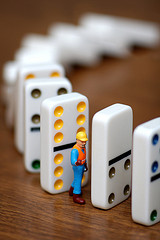 Anger and frustration are usually not very pretty, especially when your anxious child expresses them in the form of a frantic tantrum in the middle of the supermarket candy aisle. Before trying to quell your child with punishment (“You’re going straight to your room when we get home!”) or with reward (“I’ll buy you the candy already!”), you may be better off if you understand exactly what’s going on.
Anger and frustration are usually not very pretty, especially when your anxious child expresses them in the form of a frantic tantrum in the middle of the supermarket candy aisle. Before trying to quell your child with punishment (“You’re going straight to your room when we get home!”) or with reward (“I’ll buy you the candy already!”), you may be better off if you understand exactly what’s going on.
Anxious children like those our self-guided program was developed for can become more easily frustrated or angered because they are already on edge from all the stress, fear and worry that comes with anxiety. While younger children may throw tantrums, older children can act out with behavior that appears defiant, stubborn or obnoxious.
All of the above can stem from behavioral problems, as some of the updates in the 2013 Diagnostic and Statistical Manual of Mental Disorders, or DSM-5, may lead you to believe. Or they can stem from anxiety, frustration and anger, all of which are linked in different ways.
Anger and Frustration Link
Anger and frustration are linked, but they are two different things. Psychology Today notes that frustration is much more complex than being just a negative emotion. It is an innate reaction when things don’t go our way. And it’s not always negative.
“Frustration starts as a good emotion because when we get frustrated, we are motivated to remove the obstacle that is blocking our path toward our goals,” Psychology Today says. “We try harder and that extra effort frequently results in clearing that path enabling us to continue pursuit of our goals.”
And then there are the times where frustration can rapidly and violently transform into anger. That’s where Psychology Today says an entire negative emotional chain can set in. The negative chain, of course, can be broken at any time by a positive outcome, but that’s not always the case.
 Here comes the chain:
Here comes the chain:
- Your child tries something and it doesn’t work out
- Frustration sets in, makes them work harder and the thing works = end of story
- Frustration sets in, makes them work harder and the thing doesn’t work
- Frustration intensifies, turning into anger
- Anger motivates, yet clouds the mind and reduces physical coordination, and the thing still doesn’t work
- Enter despair, which leads to feeling bad, quitting and giving up hope
If despair becomes a constant result, kids can eventually start giving up hope or making any effort to achieve anything worthwhile. They may honestly start to believe they cannot achieve anything worthwhile.
The trick to stopping the horrible chain is to nip the chain at the frustration level. As parents, you largely lead by example. If your own frustration turns into cussing, kicking and throwing things across the room, your child will learn that dealing with frustration by expressing anger is the way to go.
If you react with frustration and anger when your child is experiencing his or her own frustration, the situation can get even worse. It sets the stage for a negative mess of emotions, potential tantrums or other “oppositional behavior” and can spiral through the steady chain of negative emotion, ending in total despair.
You’ll set a much healthier example if you instead respond to your child’s frustration with a calm and soothing voice, offering ways you can help them deal with it. This solution can provide an instant calm while illustrating there are better ways to deal with frustration than throwing something against the wall.
Anger and Anxiety Link
 Anger and anxiety are linked, with the former often expressed by negative behavior. A study published in Early Childhood Research and Practice found that anxiety and tantrums in younger children were indeed linked, supporting earlier research that found a link between anxiety and oppositional behavior in older children.
Anger and anxiety are linked, with the former often expressed by negative behavior. A study published in Early Childhood Research and Practice found that anxiety and tantrums in younger children were indeed linked, supporting earlier research that found a link between anxiety and oppositional behavior in older children.
Regardless of age, it appears anxious children are more prone to acting out, be it in a screaming heap in the supermarket candy aisle or with an angry outburst at their middle school English teacher. The study also pointed out the behavior of children who suffer from untreated anxiety at an early age can continue to escalate as the children get older.
One more juicy tidbit that came out of the study is the way tantrums are often dealt with.
The study notes: “If youngsters can manifest anxiety in the externalizing behavior of a tantrum, then perhaps one should reconsider the intervention techniques that are often recommended to parents and early childhood educators (e.g., time-out, isolation), some of which may serve to increase anxiety.”
That means a punishment for an angry outburst that stems from anxiety can make the anxiety and anger fester and grow. That may explain why some children do not calm down but only scream louder in anguish when banished to their rooms following a tantrum.
Discerning if a tantrum or oppositional behavior is fueled by anxiety or frustration can pose another challenge, as most of the study participants did not rank fear, nervousness or worry as evident before the tantrum occurred. Recognizing the outburst as a response to anxiety and frustration, rather than a ploy to ensure you buy more candy, is crucial to providing an effective response.
Tips to Help Anxious Children Deal with Anger
 Instead of banishing a child to his or her room in isolation, a wholly different suggestion comes from a report by Aletha Solter published in Young Children. Solter suggested parents instead stay close to child after an anxiety-induced tantrum while trying to figure out the cause of the anxiety and frustration.
Instead of banishing a child to his or her room in isolation, a wholly different suggestion comes from a report by Aletha Solter published in Young Children. Solter suggested parents instead stay close to child after an anxiety-induced tantrum while trying to figure out the cause of the anxiety and frustration.
This can consist of a few calming phrases, such as “You’ve had a bad day,” or “You must be disappointed by how things turned out.” This can be more effective for alleviating anxiety since it doesn’t make children feel like they are being punished just because they are filled with frustration, worry, fear and those other fine qualities that tend to come with anxiety.
You may still have to take your child quickly out of the candy aisle, but at least you can attempt a meaningful response once you hit the parking lot. If your child happens to be too upset to even attempt to talk about anything, Solter gives another key piece of advice:
Let them cry.
It’s said tears can heal, and they can also work wonders at purging out anxiety and other strong emotions. Your goal then becomes to comfort the child, helping to induce the relaxation that is so well-known for further alleviating anxiety. Other relaxation techniques can include:
- Moving to a quiet area
- Using a calming voice
- Encouraging your child to practice breathing exercises
- Encouraging your child to discuss the underlying issue causing the anxiety that led to the tantrum
Tips to Help Anxious Children Deal with Frustration
If your anxious child’s state has yet to reach anger and is still in the frustration zone, Psychology Today offers several helpful tips:
Respond positively when your child expresses frustration. Instead of becoming angry or frustrated yourself, try the calming voice with suggestions on things you can do to help remedy the situation or quell whatever it is your child is frustrated about.
Don’t automatically think your child just needs to “try harder” to make something work. Trying harder, but not changing the way of doing something, can only result in harder failure. Instead, try a different approach that may work when the first approach did not.
Take a break. Your anxious child may also need a brief, relaxing break before he or she tries the task again. Listening to music, having a snack, taking a short walk or otherwise engaging in something that clears the mind can do loads of good for returning to successfully complete a task.
Realize kids, like adults, can sometimes just have a really crummy day. We all have days when nothing seems to work in our favor. Those days are usually best spent putting difficult tasks aside until we can come back when we are refreshed, renewed and able to put forth the best efforts another day will bring.
SOURCES:
- http://www.psychologytoday.com/blog/the-power-prime/201009/parenting-frustration-in-children-aarrgghh
- http://ecrp.uiuc.edu/v9n2/mireault.html
Study info:
- Solter, Aletha. (1992). Understanding tears and tantrums. Young Children, 47(4), 64-68.
Photo Credits: John Flinchbaugh, Juan R. Martos, Tambako the Jaguar





